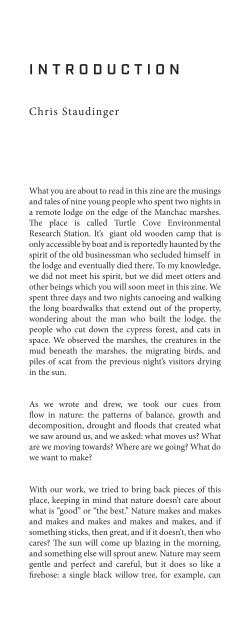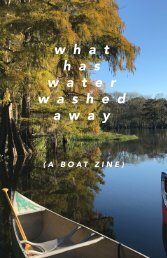In the Stomach of a Damselfly
Visual art and creative writing from New Harmony High School and the paper boat project's spring arts retreat to Turtle Cove. Published April 2019.
Visual art and creative writing from New Harmony High School and the paper boat project's spring arts retreat to Turtle Cove. Published April 2019.
Create successful ePaper yourself
Turn your PDF publications into a flip-book with our unique Google optimized e-Paper software.
INTRODUCTION<br />
Chris Staudinger<br />
What you are about to read in this zine are <strong>the</strong> musings<br />
and tales <strong>of</strong> nine young people who spent two nights in<br />
a remote lodge on <strong>the</strong> edge <strong>of</strong> <strong>the</strong> Manchac marshes.<br />
The place is called Turtle Cove Environmental<br />
Research Station. It’s giant old wooden camp that is<br />
only accessible by boat and is reportedly haunted by <strong>the</strong><br />
spirit <strong>of</strong> <strong>the</strong> old businessman who secluded himself in<br />
<strong>the</strong> lodge and eventually died <strong>the</strong>re. To my knowledge,<br />
we did not meet his spirit, but we did meet otters and<br />
o<strong>the</strong>r beings which you will soon meet in this zine. We<br />
spent three days and two nights canoeing and walking<br />
<strong>the</strong> long boardwalks that extend out <strong>of</strong> <strong>the</strong> property,<br />
wondering about <strong>the</strong> man who built <strong>the</strong> lodge, <strong>the</strong><br />
people who cut down <strong>the</strong> cypress forest, and cats in<br />
space. We observed <strong>the</strong> marshes, <strong>the</strong> creatures in <strong>the</strong><br />
mud beneath <strong>the</strong> marshes, <strong>the</strong> migrating birds, and<br />
piles <strong>of</strong> scat from <strong>the</strong> previous night’s visitors drying<br />
in <strong>the</strong> sun.<br />
As we wrote and drew, we took our cues from<br />
flow in nature: <strong>the</strong> patterns <strong>of</strong> balance, growth and<br />
decomposition, drought and floods that created what<br />
we saw around us, and we asked: what moves us? What<br />
are we moving towards? Where are we going? What do<br />
we want to make?<br />
With our work, we tried to bring back pieces <strong>of</strong> this<br />
place, keeping in mind that nature doesn’t care about<br />
what is “good” or “<strong>the</strong> best.” Nature makes and makes<br />
and makes and makes and makes and makes, and if<br />
something sticks, <strong>the</strong>n great, and if it doesn’t, <strong>the</strong>n who<br />
cares? The sun will come up blazing in <strong>the</strong> morning,<br />
and something else will sprout anew. Nature may seem<br />
gentle and perfect and careful, but it does so like a<br />
firehose: a single black willow tree, for example, can




